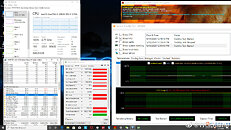- Joined
- Oct 9, 2007
- Messages
- 47,648 (7.44/day)
- Location
- Dublin, Ireland
| System Name | RBMK-1000 |
|---|---|
| Processor | AMD Ryzen 7 5700G |
| Motherboard | Gigabyte B550 AORUS Elite V2 |
| Cooling | DeepCool Gammax L240 V2 |
| Memory | 2x 16GB DDR4-3200 |
| Video Card(s) | Galax RTX 4070 Ti EX |
| Storage | Samsung 990 1TB |
| Display(s) | BenQ 1440p 60 Hz 27-inch |
| Case | Corsair Carbide 100R |
| Audio Device(s) | ASUS SupremeFX S1220A |
| Power Supply | Cooler Master MWE Gold 650W |
| Mouse | ASUS ROG Strix Impact |
| Keyboard | Gamdias Hermes E2 |
| Software | Windows 11 Pro |
A stock Intel Core i9-10900K 10-core processor was subjected to FPU stress by Chinese PC enthusiast @WolStame. The power and temperature values of the processor are inside HEDT territory. With a Furmark GPU stress running on the side, under AIDA64 FPU stress, the i9-10900K measured a package power draw of up to 235.17 W, as measured using HWInfo64. The CPU package temperature shot up to 93 °C. A 240 mm AIO liquid CPU cooling solution was used in the feat. Interestingly, the processor is able to sustain clock speeds of 4.77 GHz, which is close to the advertised 4.80 GHz all-core turbo boost frequency, called for by the multi-core FPU stress.
To show that the values weren't obtained in a few seconds of test, the AIDA64 Stability Test window keeps a timestamp log and displays time elapsed into the stress. In this particular case, the all-core stress has been running for close to 48 minutes; and yet the processor is keeping up with its advertised all-core boost speed, making this an impressive feat.

View at TechPowerUp Main Site
To show that the values weren't obtained in a few seconds of test, the AIDA64 Stability Test window keeps a timestamp log and displays time elapsed into the stress. In this particular case, the all-core stress has been running for close to 48 minutes; and yet the processor is keeping up with its advertised all-core boost speed, making this an impressive feat.

View at TechPowerUp Main Site




